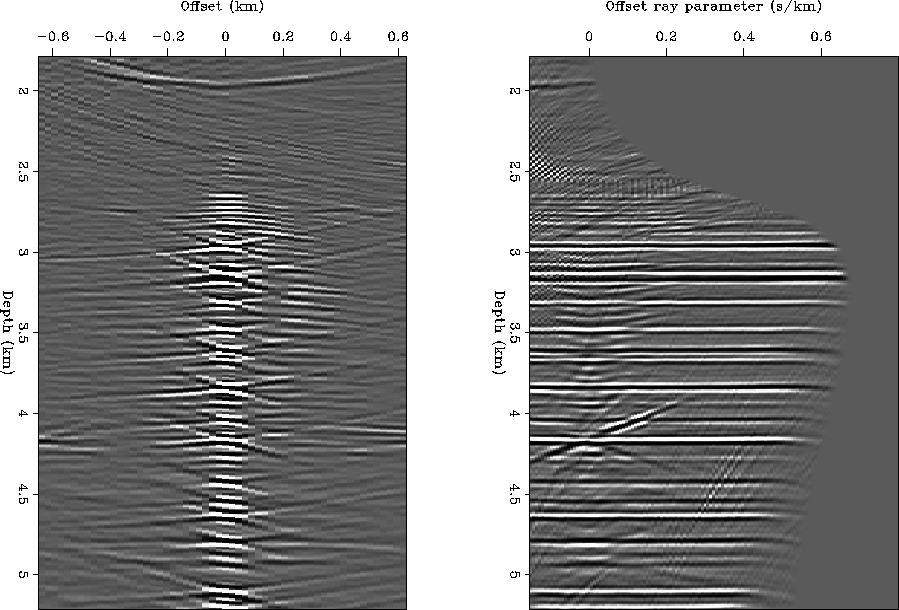




Next: Problems in ADCIGs
Up: Downward-continuation migration methods
Previous: Downward continuation
To take advantage of the information that non-zero offsets provide, we
can perform a slant stack () along the offset axis at
each depth step
before imaging. In this way we obtain an image as a function
of the offset ray parameters phx and phy:
With this method we can extract angle-domain common image gathers (CIGs)
from the new wavefield 24#24at fixed midpoint locations ().
The right panel in Figure ![[*]](http://sepwww.stanford.edu/latex2html/cross_ref_motif.gif) shows the angle-domain CIG
corresponding to the downward-continued offset gather shown
in the left panel.
By downward continuing the wavefields with the DSR equation and slant
stacking at every depth step, this method can handle lateral velocity
variations, unlike the slant stacking method proposed by ().
shows the angle-domain CIG
corresponding to the downward-continued offset gather shown
in the left panel.
By downward continuing the wavefields with the DSR equation and slant
stacking at every depth step, this method can handle lateral velocity
variations, unlike the slant stacking method proposed by ().
Strictly speaking,
the CIGs obtained by this procedure
are function of the offset ray parameters 25#25and not of the opening angle 5#5.However, in 2-D phx is linked to 5#5 by the following
simple trigonometric relationship (a similar relationship can be
found for the 3-D problem):
where 6#6 is the geological dip along the in-line
direction and 27#27 is the velocity function.
A rigorous treatment of CIGs in 3-D can be found in
().
hcig.pcig
Figure 5 Left: Offset panel after downward continuation. Right: Angle-domain CIG





() demonstrated that it is possible to perform
downward-continuation migration in such a way as to get CIGs that have
an axis of
reflection angle rather than offset ray parameter. This method
of obtaining CIGs is based on the relationship between
the reflection angle 5#5 and the local subsurface offset as
where kh is the local subsurface offset wavenumber. Since the
offset involved in their methodology is related to the subsurface rather
than the surface, the CIGs produced will be free of many of the artifacts
seen in CIGs from surface related techniques.





Next: Problems in ADCIGs
Up: Downward-continuation migration methods
Previous: Downward continuation
Stanford Exploration Project
10/31/2005
![[*]](http://sepwww.stanford.edu/latex2html/cross_ref_motif.gif) shows the angle-domain CIG
corresponding to the downward-continued offset gather shown
in the left panel.
By downward continuing the wavefields with the DSR equation and slant
stacking at every depth step, this method can handle lateral velocity
variations, unlike the slant stacking method proposed by ().
shows the angle-domain CIG
corresponding to the downward-continued offset gather shown
in the left panel.
By downward continuing the wavefields with the DSR equation and slant
stacking at every depth step, this method can handle lateral velocity
variations, unlike the slant stacking method proposed by ().
